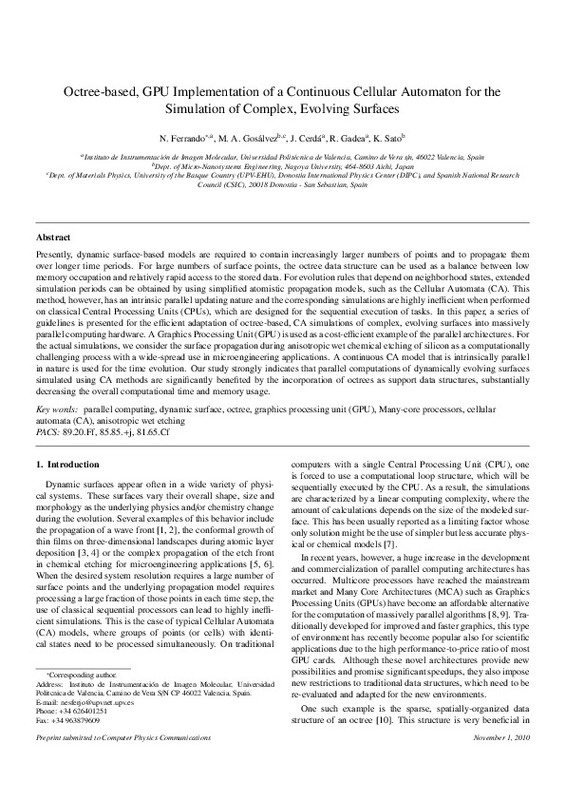JavaScript is disabled for your browser. Some features of this site may not work without it.
Buscar en RiuNet
Listar
Mi cuenta
Estadísticas
Ayuda RiuNet
Admin. UPV
Octree-based, GPU implementation of a continuous cellular automaton for the simulation of complex, evolving surfaces
Mostrar el registro sencillo del ítem
Ficheros en el ítem
| dc.contributor.author | Ferrando Jódar, Néstor
|
es_ES |
| dc.contributor.author | Gosalvez, M.A.
|
es_ES |
| dc.contributor.author | Cerdá Boluda, Joaquín
|
es_ES |
| dc.contributor.author | Gadea Gironés, Rafael
|
es_ES |
| dc.contributor.author | Sato, K.
|
es_ES |
| dc.date.accessioned | 2015-09-11T10:28:33Z | |
| dc.date.available | 2015-09-11T10:28:33Z | |
| dc.date.issued | 2011-03 | |
| dc.identifier.issn | 0010-4655 | |
| dc.identifier.uri | http://hdl.handle.net/10251/54529 | |
| dc.description.abstract | Presently, dynamic surface-based models are required to contain increasingly larger numbers of points and to propagate them over longer time periods. For large numbers of surface points, the octree data structure can be used as a balance between low memory occupation and relatively rapid access to the stored data. For evolution rules that depend on neighborhood states, extended simulation periods can be obtained by using simplified atomistic propagation models, such as the Cellular Automata (CA). This method, however, has an intrinsic parallel updating nature and the corresponding simulations are highly inefficient when performed on classical Central Processing Units (CPUs), which are designed for the sequential execution of tasks. In this paper, a series of guidelines is presented for the efficient adaptation of octree-based, CA simulations of complex, evolving surfaces into massively parallel computing hardware. A Graphics Processing Unit (GPU) is used as a cost-efficient example of the parallel architectures. For the actual simulations, we consider the surface propagation during anisotropic wet chemical etching of silicon as a computationally challenging process with a wide-spread use in microengineering applications. A continuous CA model that is intrinsically parallel in nature is used for the time evolution. Our study strongly indicates that parallel computations of dynamically evolving surfaces simulated using CA methods are significantly benefited by the incorporation of octrees as support data structures, substantially decreasing the overall computational time and memory usage. © 2010 Elsevier B.V. All rights reserved. | es_ES |
| dc.description.sponsorship | We thank the anonymous reviewers for their valuable comments and suggestions. This work has been supported by Programa de Becas de Excelencia de la Universidad Politecnica de Valencia (PAID-09-09), MEXT Grant in Aid Research (Kakenhi: Silicon etching (A) 19201026), and the Global COE program of Japan (GCOE, Wakate JSPS Young Scientist Fund). | en_EN |
| dc.language | Inglés | es_ES |
| dc.publisher | Elsevier | es_ES |
| dc.relation.ispartof | Computer Physics Communications | es_ES |
| dc.rights | Reconocimiento - No comercial - Sin obra derivada (by-nc-nd) | es_ES |
| dc.subject | Anisotropic wet etching | es_ES |
| dc.subject | Cellular Automata | es_ES |
| dc.subject | GPU | es_ES |
| dc.subject.classification | TECNOLOGIA ELECTRONICA | es_ES |
| dc.title | Octree-based, GPU implementation of a continuous cellular automaton for the simulation of complex, evolving surfaces | es_ES |
| dc.type | Artículo | es_ES |
| dc.identifier.doi | 10.1016/j.cpc.2010.11.004 | |
| dc.relation.projectID | info:eu-repo/grantAgreement/UPV//PAID-09-09/ | es_ES |
| dc.relation.projectID | info:eu-repo/grantAgreement/MEXT//19201026/ | es_ES |
| dc.rights.accessRights | Abierto | es_ES |
| dc.contributor.affiliation | Universitat Politècnica de València. Departamento de Ingeniería Electrónica - Departament d'Enginyeria Electrònica | es_ES |
| dc.description.bibliographicCitation | Ferrando Jódar, N.; Gosalvez, M.; Cerdá Boluda, J.; Gadea Gironés, R.; Sato, K. (2011). Octree-based, GPU implementation of a continuous cellular automaton for the simulation of complex, evolving surfaces. Computer Physics Communications. 182(3):628-640. https://doi.org/10.1016/j.cpc.2010.11.004 | es_ES |
| dc.description.accrualMethod | S | es_ES |
| dc.relation.publisherversion | http://dx.doi.org/10.1016/j.cpc.2010.11.004 | es_ES |
| dc.description.upvformatpinicio | 628 | es_ES |
| dc.description.upvformatpfin | 640 | es_ES |
| dc.type.version | info:eu-repo/semantics/publishedVersion | es_ES |
| dc.description.volume | 182 | es_ES |
| dc.description.issue | 3 | es_ES |
| dc.relation.senia | 231283 | |
| dc.identifier.eissn | 1879-2944 | |
| dc.contributor.funder | Universitat Politècnica de València | es_ES |
| dc.contributor.funder | Ministry of Education, Culture, Sports, Science and Technology, Japón | es_ES |






![[Cerrado]](/themes/UPV/images/candado.png)


